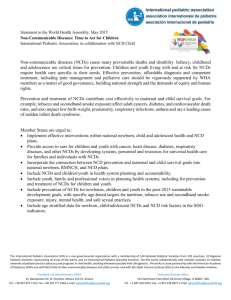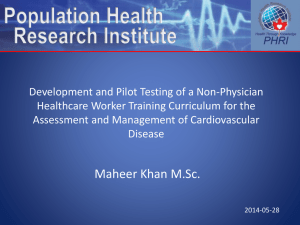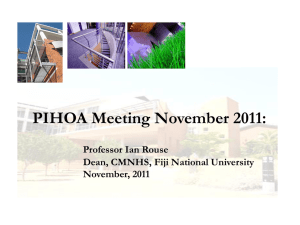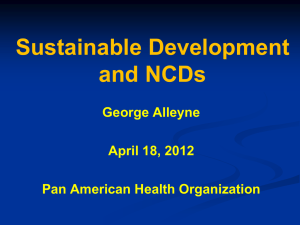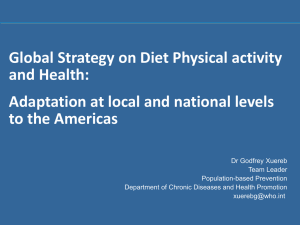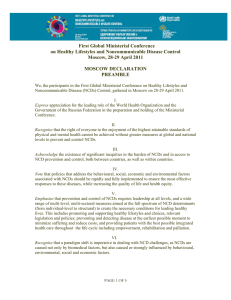fifth presentation - Global Health 2035
advertisement
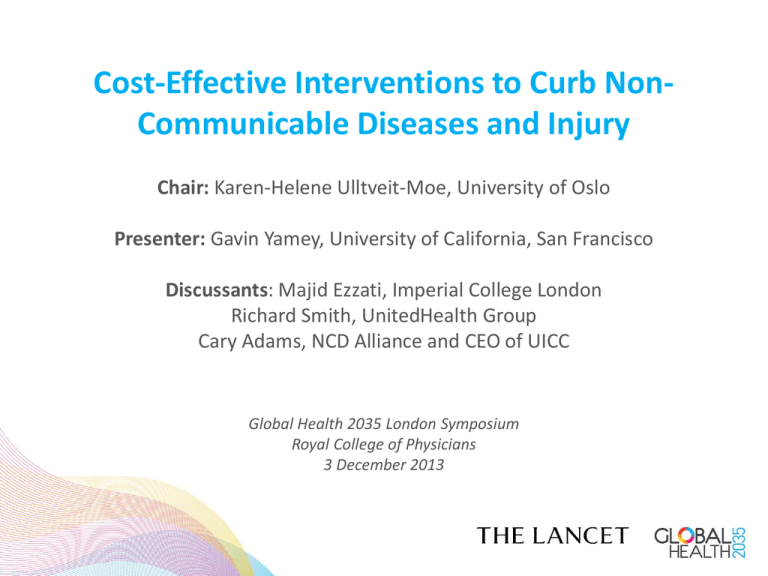
Cost-Effective Interventions to Curb NonCommunicable Diseases and Injury Chair: Karen-Helene Ulltveit-Moe, University of Oslo Presenter: Gavin Yamey, University of California, San Francisco Discussants: Majid Ezzati, Imperial College London Richard Smith, UnitedHealth Group Cary Adams, NCD Alliance and CEO of UICC Global Health 2035 London Symposium Royal College of Physicians 3 December 2013 A paradox of success Deaths from selected important causes across different income levels Age-standardized death rates from CVD are higher in all six World Bank regions than in HICs What steps can countries take to delay onset? Relations between key risk factors for major NCDs and injuries † Amenable to drug therapy Large loss of life expectancy Smoking: smoker in U.S. Loses about 10 y Obesity: 60-y-old with: • BMI 27-30 Loses about 1-2 y • BMI 30-35 Loses about 2-4 y • BMI 40-50 Loses about 8-10 y Life expectancy Pollution: 65-y-old woman in moderately polluted Chinese city Loses about 4 y Essential packages of interventions Specific interventions in each package will vary by country Depends on which risk factors dominate Population package: reduces incidence of NCDs and injuries Clinical package: reduces incidence and manages consequences We structure our population-based package by policy instrument 1 Taxes and subsidies 3 Information and communication 2 Regulation and legislation 4 Built environment Essential package of population-based interventions Taxes and subsidies Laws and regulations Information Tobacco Large (170%) excise taxes* Bans on use in public places and on promotion* Mass media messages* -- Alcohol Large taxes in countries where high burden* Bans on promotion and restriction on sales* Mass media messages* -- Poor diet Tax sugar and potentially other foods Bans on salt and trans fats in processed food* Increase public awareness of healthy diet and physical activity* -- Enforce speeding and drink-driving laws -- Safe roads and vehicles Unsafe roads and vehicles -- Air pollution Reduce fossil fuel subsidies. Selectively subsidise LPG to replace kerosene for household use. Promote LPG -- Built environment -- LPG=liquefied petroleum gas. *Represent WHO best buys for control of NCDs Taxes: the single greatest opportunity is tobacco 50% rise in tobacco price from tax increases in China prevents 20 million deaths + generates extra $20 billion/y in next 50 y additional tax revenue would fall over time but would be higher than current levels even after 50 y largest share of life-years gained is in bottom income quintile Lessons from taxing tobacco and alcohol Taxes must be large to change consumption Must prevent tax avoidance (loopholes) and tax evasion (smuggling, bootlegging) Design taxes to avoid substitution Young/low-income groups respond most Subsidies: the single greatest opportunity is ending fossil fuel subsidies Multiple NCDs cancers, heart disease, lung disease, respiratory infection Health and economic impacts Expenditures Subsidies (post-tax) were US $2.0 trillion in 2011 Energy subsidy reform is a crucial lever to curb NCDs Three other policy instruments 2Regulation 3Information and legislation and communication Powerful, immediate government lever: ban industrially produced trans fats 4Built Dietary information improves knowledge but little evidence of behaviour change environment Substituting solid fuels with cleaner technologies; electricity, LPG globalhealth2035.org Essential package of clinical interventions WHO “best buys” NCD Intervention Liver cancer Hepatitis B vaccine Cervical cancer VIA and treatment of precancerous lesions CVD and diabetes Counselling and multi-drug therapy for high-risk patients Heart attack Aspirin We recommend scale-up in all countries Cost-effective Low coverage 80% coverage by 2020 would avert 37% of global burden of cardiovascular disease Except for hepatitis B vaccine, very low coverage across LICs/MICs Feasible 1st step for all countries; costs $9bn/y; we argue that HPV vaccine should be included Phased expansion pathways Choice of packages and expansion pathway will vary with pattern of disease, delivery capacity, domestic health spending Why did we include childhood cancers? Disease Control Priorities Project 3rd edition examines evidence on treating pediatric cancers in a range of LICs/MICs Treating common childhood malignancies in many settings would be cost-effective: treatments are effective and those cured can live for decades Malawi: treating a single child with Burkitt lymphoma would be very cost-effective up to a cost of US $14,000 (actual cost of chemotherapy + supportive drugs is US $50) Hesseling PB. Burkitt lymphoma treatment: the Malawi experience. J Afr Cancer 2009;1:72–9. Sudden price drops affect expansion pathway For drugs, diagnostics, and vaccines, which can usually be delivered without complex infrastructure, price reductions can sometimes occur very rapidly Price Price drop might be large enough for intervention to be used earlier in expansion pathway “Interventions don’t deliver themselves” Community outreach Clinics District hospitals Referral hospitals CVD, diabetes Diabetes prevention programmes Drugs for primary & secondary prevention of CVD Medical treatment of acute heart attack Angiography services Cancers HPV vaccination Cervical cancer screening/treatment Hormonal therapy and surgery for breast cancer Treatment of selected paediatric cancers Psychiatric and neurological conditions Rehabilitation for chronic psychosis Antidepressants and psychotherapy for depression or anxiety Detoxification for alcohol dependence Neurosurgery for intractable epilepsy Injuries Training of lay first responders Treatment of minor burns Management of fractured femur Complex orthopaedic surgery—e.g. for pelvic injury What role for international collective action? Curbing NCDs and Injuries Leadership and stewardship Advocacy and technical assistance for taxation, trade and subsidy policies Provision of global public goods “PPIR” (population, policy, and implementation research) Expanding the menu of cost-effective population-based and clinical interventions Surveillance on implementing the WHO FCTC Managing crossborder externalities • Regional collaboration to prevent tobacco smuggling Direct country assistance • Aid to LICs to support selected NCD and injury interventions (e.g. HPV and hepatitis B vaccines) Thank you yameyg@globalhealth.ucsf.edu www.globalhealth2035.org
